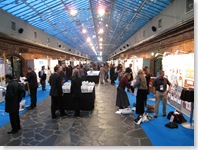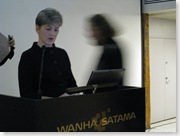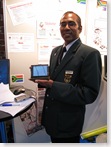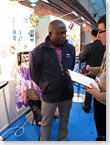3.6 Million Innovative Teachers Can't Be Wrong
Helsinki, October 29, 2007
I am attending the Worldwide Innovative Teachers Forum, a "Celebration/Competition" that Microsoft is holding in Helsinki as part  of our Innovative Teachers Network, a grassroots community around the world that promotes and celebrates cool uses of technology in the classroom. It is a component of Partners in Learning, our core program for working with governments and educators to transform education. I wish as a company we could do more to let people know about the work we are doing here, because so much of our discussion on education seems to be about computer systems and not about learning. This show is all about learning.
of our Innovative Teachers Network, a grassroots community around the world that promotes and celebrates cool uses of technology in the classroom. It is a component of Partners in Learning, our core program for working with governments and educators to transform education. I wish as a company we could do more to let people know about the work we are doing here, because so much of our discussion on education seems to be about computer systems and not about learning. This show is all about learning.
And this is not, I repeat not, a typical Microsoft event. Sure, we have opening keynotes, in this case from Lauren Woodman and Dave  Walddon (both shown at right, Dave is spectral) along with two educators from Finland. But the heart of the event is teachers. There are no customers, no buyers, no trade show vendors, and no salespeople. Just teachers -- about 260 of them from 40 countries -- all coming together to present and discuss 85 examples of innovative best practices. These 85 were the "winners" from about 100,000 submissions of lesson plans and course curricula from teachers worldwide. (Partners in Learning has touched 3.6 million teachers since the program started a few years ago.)
Walddon (both shown at right, Dave is spectral) along with two educators from Finland. But the heart of the event is teachers. There are no customers, no buyers, no trade show vendors, and no salespeople. Just teachers -- about 260 of them from 40 countries -- all coming together to present and discuss 85 examples of innovative best practices. These 85 were the "winners" from about 100,000 submissions of lesson plans and course curricula from teachers worldwide. (Partners in Learning has touched 3.6 million teachers since the program started a few years ago.)
The show has the feel of a science fair, except instead of kids the participants are teachers who developed really interesting learning modules. And there is a competition, we will be announcing final "winners" at a dinner tomorrow night. But it is mainly a celebration of the great teaching demonstrated by all of the projects.
 If you walk the show floor, you can see why. (I will try to post a list of all the entrants later this week.) There is a team from Thailand that had a project where the kids made claymation videos. The teachers had examples of the clay statues in their booth and were showing the videos on a Zune. It looks like something you'd see on television, except it was created by high school kids in Thailand.
If you walk the show floor, you can see why. (I will try to post a list of all the entrants later this week.) There is a team from Thailand that had a project where the kids made claymation videos. The teachers had examples of the clay statues in their booth and were showing the videos on a Zune. It looks like something you'd see on television, except it was created by high school kids in Thailand.
 A team from northern China had a project where they taught children about puppetry, an ancient art in their region. The children interviewed local puppet craftsman and performers, made a film about it, and then made their own puppets (a couple of examples are shown to the right.)
A team from northern China had a project where they taught children about puppetry, an ancient art in their region. The children interviewed local puppet craftsman and performers, made a film about it, and then made their own puppets (a couple of examples are shown to the right.)
A teacher from Sweden demonstrated a project on the topic of biodiversity that involved a networked collaboration between her classroom and a classroom in Madagascar. This project had the added benefit of helping children in both countries learn English.
There were two strong entries from South Africa. One of the teachers built an "mLearning" system, complete with quizzes and online homework assignments broadcast to the students' cell phones (all of the 12th grade students in his class had one -- and as I've said before, there is more to our approach for using technology to transform education than simply deploying PCs). The other teacher built a module for his rural students called "Bright Lights, Dustbowl" that had the kids do all sorts of interesting activities ranging from visiting the local "city" to parsing songs by the Police to creating online and radio advertisements for local businesses. He even played some of the radio ads for us.
To me, this conference seems little different from Microsoft's software developer community events I was involved with in the 1990s, except instead of geeks showing off their Visual Basic applications, you have teachers showing off their geography lessons. And just as developers were always a core community for Microsoft in its first 30 years -- we never "sold" to developers, we always had to excite and inspire them to do cool and great things with our tools -- teachers are a core community for Microsoft moving forward. And it is great to participate in a showcase of what inspired teachers can do when they have the right tools.


